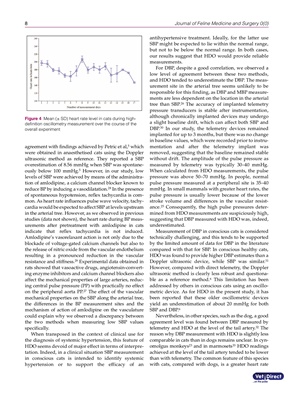
8 Journal of Feline Medicine and Surgery 0(0)
agreement with findings achieved by Petric et al,5 which
were obtained in anaesthetised cats using the Doppler
ultrasonic method as reference. They reported a SBP
overestimation of 8.56 mmHg when SBP was spontaneously below 100 mmHg.5
However, in our study, low
levels of SBP were achieved by means of the administration of amlodipine, a calcium channel blocker known to
reduce BP by inducing a vasodilatation.28 In the presence
of spontaneous hypotension, reflex tachycardia is common. As
heart rate influences pulse wave velocity, tachycardia
would be expected to affect SBP at levels upstream
in the arterial tree. However, as we observed in previous
studies (data not shown), the heart rate during BP measurements
after pretreatment with amlodipine in cats
indicate that reflex tachycardia is not induced.
Amlodipine's vasorelaxant action is not only due to the
blockade of voltage-gated calcium channels but also to
the release of nitric oxide from the vascular endothelium
resulting in a pronounced reduction in the vascular
resistance and stiffness.29 Experimental data obtained in
rats showed that vasoactive drugs, angiotensin-converting enzyme inhibitors and calcium channel blockers also
affect the mechanical properties of large arteries, reducing central
pulse pressure (PP) with practically no effect
on the peripheral aorta PP.27 The effect of the vascular
mechanical properties on the SBP along the arterial tree,
the differences in the BP measurement sites and the
mechanism of action of amlodipine on the vasculature
could explain why we observed a discrepancy between
the two methods when measuring low SBP values
specifically.
When transposed in the context of clinical use for
the diagnosis of systemic hypertension, this feature of
HDO seems devoid of major effect in terms of interpretation. Indeed, in a clinical situation SBP
measurement
in conscious cats is intended to identify systemic
hypertension or to support the efficacy of an antihypertensive treatment. Ideally, for the latter use
SBP might be expected to lie within the normal range,
but not to be below the normal range. In both cases,
our results suggest that HDO would provide reliable
measurements.
For DBP, despite a good correlation, we observed a
low level of agreement between these two methods,
and HDO tended to underestimate the DBP. The measurement
site in the arterial tree seems unlikely to be
responsible for this finding, as DBP and MBP measurements are
less dependent on the location in the arterial
tree than SBP.26 The accuracy of implanted telemetry
pressure transducers is stable after instrumentation,
although chronically implanted devices may undergo
a slight baseline drift, which can affect both SBP and
DBP.30 In our study, the telemetry devices remained
implanted for up to 3 months, but there was no change
in baseline values, which were recorded prior to instrumentation and after the telemetry implant was
removed, suggesting that the baseline remained stable
without drift. The amplitude of the pulse pressure as
measured by telemetry was typically 30-40 mmHg.
When calculated from HDO measurements, the pulse
pressure was above 50-70 mmHg. In people, normal
pulse pressure measured at a peripheral site is 35-40
mmHg. In small mammals with greater heart rates, the
pulse pressure is usually lower because of the lower
stroke volume and differences in the vascular resistance.25
Consequently, the high pulse pressures determined from
HDO measurements are suspiciously high,
suggesting that DBP measured with HDO was, indeed,
underestimated.
Measurement of DBP in conscious cats is considered
technically challenging, and this tends to be supported
by the limited amount of data for DBP in the literature
compared with that for SBP. In conscious healthy cats,
HDO was found to provide higher DBP estimates than a
Doppler ultrasonic device, while SBP was similar.31
However, compared with direct telemetry, the Doppler
ultrasonic method is clearly less robust and questionable as a reference
method.6 This limitation has been
addressed by others in conscious cats using an oscillometric device. As
for HDO in the present study, it has
been reported that these older oscillometric devices
yield an underestimation of about 20 mmHg for both
SBP and DBP.6
Nevertheless, in other species, such as the dog, a good
agreement level was found between DBP measured by
telemetry and HDO at the level of the tail artery.32 The
reason why DBP measurement with HDO is slightly less
comparable in cats than in dogs remains unclear. In cynomolgus monkeys23
and in marmosets33 HDO readings
achieved at the level of the tail artery tended to be lower
than with telemetry. The common feature of this species
with cats, compared with dogs, is a greater heart rate
Figure 4 Mean (± SD) heart rate level in cats during highdefinition oscillometry
measurement over the course of the
overall experiment